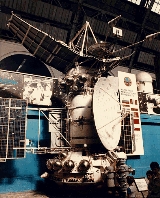
Venera 15 and 16
Encyclopedia

Spacecraft
A spacecraft or spaceship is a craft or machine designed for spaceflight. Spacecraft are used for a variety of purposes, including communications, earth observation, meteorology, navigation, planetary exploration and transportation of humans and cargo....
sent to Venus
Venus
Venus is the second planet from the Sun, orbiting it every 224.7 Earth days. The planet is named after Venus, the Roman goddess of love and beauty. After the Moon, it is the brightest natural object in the night sky, reaching an apparent magnitude of −4.6, bright enough to cast shadows...
by the Soviet Union
Soviet Union
The Soviet Union , officially the Union of Soviet Socialist Republics , was a constitutionally socialist state that existed in Eurasia between 1922 and 1991....
, consisting of Venera 15
Venera 15
Venera 15 was a spacecraft sent to Venus by the Soviet Union. This unmanned orbiter was to map the surface of Venus using high resolution imaging systems...
and Venera 16
Venera 16
Venera 16 was a spacecraft sent to Venus by the Soviet Union. This unmanned orbiter was to map the surface of Venus using high resolution imaging systems...
. Both unmanned orbiters were to map the surface of Venus using high resolution imaging systems. The spacecraft were identical and based on modifications to the earlier Venera
Venera
The Venera series probes were developed by the Soviet Union between 1961 and 1984 to gather data from Venus, Venera being the Russian name for Venus...
space probes.
Mission profile
Venera 15 was launched on June 2, 1983 at 02:38:39 UTCCoordinated Universal Time
Coordinated Universal Time is the primary time standard by which the world regulates clocks and time. It is one of several closely related successors to Greenwich Mean Time. Computer servers, online services and other entities that rely on having a universally accepted time use UTC for that purpose...
, and Venera 16 on June 7, 1983 at 02:32:00 UTC. Venera 15 and Venera 16 both reached Venus' orbit (on October 10, 1983 and October 14, 1983 respectively).
The two spacecraft were inserted into Venus orbit a day apart with their orbital planes shifted by an angle of approximately 4° relative to one another. This made it possible to reimage an area if necessary. Each spacecraft was in a nearly polar orbit with a periapsis ~1000 km, at 62°N latitude, and apoapsis ~65000 km, with an inclination
Inclination
Inclination in general is the angle between a reference plane and another plane or axis of direction.-Orbits:The inclination is one of the six orbital parameters describing the shape and orientation of a celestial orbit...
~90°, the orbital period being ~24 hours.
In June 1984, Venus was at superior conjunction and passed behind the Sun as seen from Earth. No transmissions were possible, so the orbit of Venera 16 was rotated back 20° at this time to map the areas missed during this period.
Together, the two spacecraft imaged the area from the north pole down to about 30°N latitude (i.e. approx. 25 % of Venus surface) over the 8 months of mapping operations.
Spacecraft structure
The Venera 15 and 16 spacecraft were identical and were based on modifications to the orbiter portions of the Venera 9Venera 9
Venera 9 was a USSR unmanned space mission to Venus. It consisted of an orbiter and a lander. It was launched on June 8, 1975 02:38:00 UTC and weighed 4,936 kg...
and Venera 14
Venera 14
Venera 14 was a probe in the Soviet Venera program for the exploration of Venus.Venera 14 was identical to the Venera 13 spacecraft and built to take advantage of the 1981 Venus launch opportunity and launched 5 days apart...
probes. Each spacecraft consisted of a 5 m long cylinder with a 0.6 m diameter, 1.4 m tall parabolic dish antenna for the synthetic aperture radar (SAR) at one end. A 1 meter diameter parabolic dish antenna for the radio altimeter was also located at this end. The electrical axis of the radio altimeter antenna was lined up with the axis of the cylinder. The electrical axis of the SAR deviated from the spacecraft axis by 10 degrees. During imaging, the radio altimeter would be lined up with the center of the planet (local vertical) and the SAR would be looking off to the side at 10 degrees. A bulge at the opposite end of the cylinder held fuel tanks and propulsion units. Two square solar arrays extended like wings from the sides of the cylinder. A 2.6 m radio dish antenna for communications was also attached to the side of the cylinder. The spacecraft each massed 4000 kg.
Both Venera 15 and 16 were equipped with a Synthetic Aperture Radar (SAR). A radar
Radar
Radar is an object-detection system which uses radio waves to determine the range, altitude, direction, or speed of objects. It can be used to detect aircraft, ships, spacecraft, guided missiles, motor vehicles, weather formations, and terrain. The radar dish or antenna transmits pulses of radio...
was necessary in this mission because nothing else would be able to penetrate the dense clouds of Venus. The probes were equipped with on board computers that saved the images until the entire image was complete.

